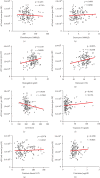The Course of Circulating Small Extracellular Vesicles in Patients Undergoing Surgical Aortic Valve Replacement
- PMID: 32382562
- PMCID: PMC7193280
- DOI: 10.1155/2020/6381396
The Course of Circulating Small Extracellular Vesicles in Patients Undergoing Surgical Aortic Valve Replacement
Abstract
In the last years, increasing efforts have been devoted to investigating the role of small extracellular vesicles (sEVs) in cardiovascular diseases. These nano-sized particles (30-150 nm), secreted by different cell types, contain signalling molecules that enable participation in intercellular communication processes. In this study, we examined the course of circulating sEVs in patients undergoing surgical aortic valve replacement (SAVR) and correlated them with echocardiographic and standard blood parameters. Peripheral blood samples were collected from 135 patients undergoing SAVR preoperatively and at three follow-up points. Circulating sEVs were precipitated using Exoquick™ exosome isolation reagent and analyzed by nanoparticle tracking analysis (NTA). Our findings indicate that no more than 7 days after SAVR, there was a marked increase of circulating sEVs before returning to initial values after 3 months. Further, shear stress is not a trigger for the formation and release of circulating sEVs. Moreover, we pointed out a correlation between circulating sEVs and erythrocytes as well as LDH and creatinine levels in peripheral blood. Finally, all patients with a moderate prosthesis-patient mismatch as well as with an impaired left ventricular mass regression had lower levels of circulating sEVs 3 months after SAVR compared to their respective status before surgery. We conclude that in patients with aortic valve stenosis (AVS), sEVs may play an important part in mediating cell-cell communication and SAVR may have a crucial and lasting impact on their circulating levels. Besides, lower levels of sEVs portend to be associated with inferior recovery after major surgical interventions. The additional use of circulating sEVs beyond echocardiographic and laboratory parameters could have a prognostic value to estimate adverse outcomes in patients undergoing SAVR.
Copyright © 2020 Andreas Weber et al.
Conflict of interest statement
The authors declare no competing interests.
Figures






Similar articles
-
Self-Expanding Transcatheter Aortic Valve Replacement Versus Surgical Valve Replacement in Patients at High Risk for Surgery: A Study of Echocardiographic Change and Risk Prediction.Circ Cardiovasc Interv. 2016 Jun;9(6):e003426. doi: 10.1161/CIRCINTERVENTIONS.115.003426. Circ Cardiovasc Interv. 2016. PMID: 27313280 Clinical Trial.
-
Computed Tomography-Based Indexed Aortic Annulus Size to Predict Prosthesis-Patient Mismatch.Circ Cardiovasc Interv. 2019 Apr;12(4):e007396. doi: 10.1161/CIRCINTERVENTIONS.118.007396. Circ Cardiovasc Interv. 2019. PMID: 30929507
-
Right ventricular function after aortic valve replacement: a pilot study comparing surgical and transcatheter procedures using 3D echocardiography.Eur J Cardiothorac Surg. 2016 Mar;49(3):966-71. doi: 10.1093/ejcts/ezv227. Epub 2015 Jun 30. Eur J Cardiothorac Surg. 2016. PMID: 26130077
-
Transcatheter aortic valve replacement versus surgical aortic valve replacement in low-surgical-risk patients: An updated meta-analysis.Catheter Cardiovasc Interv. 2020 Jul;96(1):169-178. doi: 10.1002/ccd.28520. Epub 2019 Oct 21. Catheter Cardiovasc Interv. 2020. PMID: 31631514
-
Time course of the survival advantage of transcatheter over surgical aortic valve replacement: Interplay between sex and patient risk profile.Catheter Cardiovasc Interv. 2019 Nov 1;94(5):746-752. doi: 10.1002/ccd.28124. Epub 2019 Feb 28. Catheter Cardiovasc Interv. 2019. PMID: 30821116
Cited by
-
Effects of general anaesthesia with an inhalational anaesthetic agent on the expression of exosomes in rats.Int J Med Sci. 2022 Aug 8;19(9):1399-1407. doi: 10.7150/ijms.72565. eCollection 2022. Int J Med Sci. 2022. PMID: 36035371 Free PMC article.
-
Potential Applications and Functional Roles of Exosomes in Cardiometabolic Disease.Pharmaceutics. 2021 Dec 2;13(12):2056. doi: 10.3390/pharmaceutics13122056. Pharmaceutics. 2021. PMID: 34959338 Free PMC article. Review.
-
Decrease in Cellular Nanovesicles Concentration in Blood of Athletes More Than 15 Hours After Marathon.Int J Nanomedicine. 2021 Jan 20;16:443-456. doi: 10.2147/IJN.S282200. eCollection 2021. Int J Nanomedicine. 2021. PMID: 33505159 Free PMC article.
-
Extracellular vesicles in cardiac repair and regeneration: Beyond stem-cell-based approaches.Front Cell Dev Biol. 2022 Sep 2;10:996887. doi: 10.3389/fcell.2022.996887. eCollection 2022. Front Cell Dev Biol. 2022. PMID: 36120584 Free PMC article. Review.
-
Role of Extracellular Vesicles as Potential Diagnostic and/or Therapeutic Biomarkers in Chronic Cardiovascular Diseases.Front Cell Dev Biol. 2022 Jan 26;10:813885. doi: 10.3389/fcell.2022.813885. eCollection 2022. Front Cell Dev Biol. 2022. PMID: 35155428 Free PMC article. Review.
References
-
- Osnabrugge R. L., Mylotte D., Head S. J., et al. Aortic stenosis in the elderly: disease prevalence and number of candidates for transcatheter aortic valve replacement: a meta-analysis and modeling study. Journal of the American College of Cardiology. 2013;62(11):1002–1012. doi: 10.1016/j.jacc.2013.05.015. - DOI - PubMed
Publication types
MeSH terms
LinkOut - more resources
Full Text Sources

